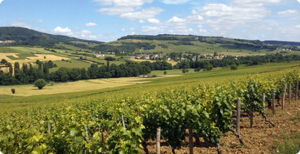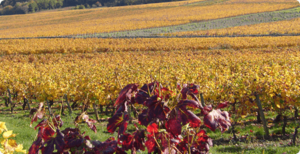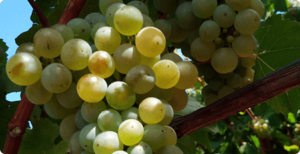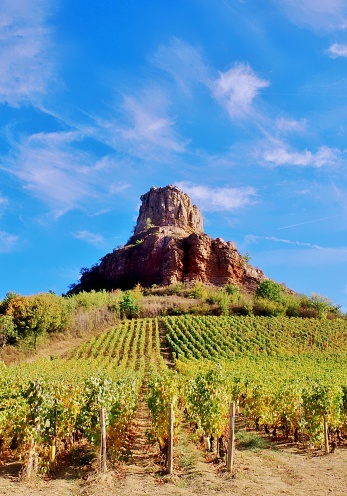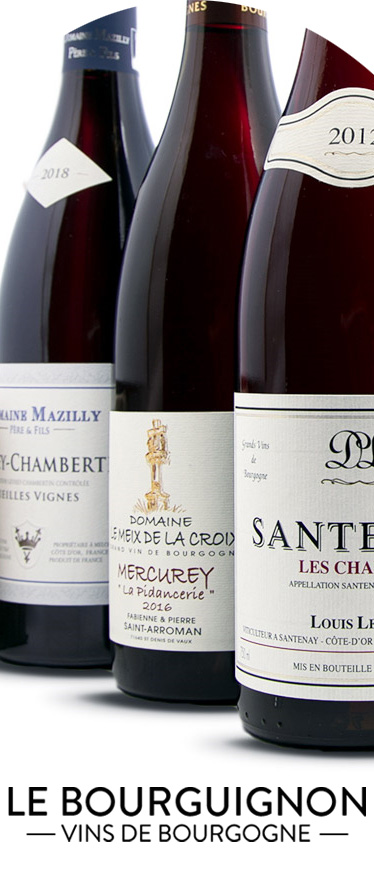The Mâconnais offers wines of very good quality at competitive prices and a worldwide reputation!
The southern gateway to Burgundy
The Mâconnais vineyard is located in the south of the department, between Sennecey le Grand and Saint-Vérand, at the gates of Beaujolais (it extends over 35 kilometers long, 10 kilometers wide and represents a quarter of the Burgundy vineyard). This region is bounded by two valleys: that of the Grosne to the west and that of the Saône, to the east.
Hills, valleys, varied landscapes, magnificent villages, thousands of hectares of vineyards planted in Gallo-Roman times,… the Mâconnais is an incredible region, to visit as soon as possible!
This diversity makes it possible to find varied soils (calcareous, calcium, siliceous, clayey or sandy brown soils; often mixed with chailles or sandstone pebbles).
A #panoramique #vue of #mâconnais thanks to a #pied #balade at Mont #Pouilly! 📷😀
➡️https://t.co/kN0huJY5lI pic.twitter.com/TGif4Kpx8E — CVM Bourgogne (@VivezMaconnais) January 16, 2017
In Burgundy, the different plots determine a regional, communal, premier cru and grand cru appellation according to their geographical location.
Hierarchy of appellations in Burgundy
In order to better navigate, its 83 appellations have been divided into 4 levels:
- Grands Cru appellations
- Premiers cru appellations
- Communal appellations (villages)
- Regional names (sometimes called "generic" or "sub-regional")
The Mâconnais
| The Grands Crus of Burgundy are at the top of the hierarchy since they have the best exposures and the most favorable microclimates . They are big names known internationally. |
Unfortunately no grand cru in the Mâconnais.
•
| The first growths of Burgundy are below the grands crus but they remain great wines as well. Each bottle is followed by the name of the plot and respects strict specifications (spacing between vines, pruning,…). |
Big news: 22 climates in the premier cru appellation for Pouilly-Fuissé
Previously the Mâconnais was the only region of Burgundy not to have premier crus, which made it its weakness.
The 22 Climats en Premier Cru of the Pouilly-Fuissé appellation, by commune:
Commune of Fuissé:
- The Brulés
- The Perrières
- The White Vines
- The Clos
- The Menieres
- The Reisses
Commune of Solutré-Pouilly:
- The Frérie
- The Clos de Solutré
- In Servy
- In Chailloux
- At the Bouthières
- In Vignerais
- Pouilly
- Towards Cras (part of the climate is on Fuissé)
Commune of Vergisson:
- In France
- About La Roche
- The Crays
- The Maréchaude
Commune of Chaintré:
- The Chevrières
- Le Clos de Monsieur Noly
- At the Quarters
- The Clos Reyssier
=> Other appellations of the Mâconnais have applied to the National Institute of Origin and Quality (INAO): Pouilly-Vinzelles, Pouilly-Loché and Saint-Véran (the file is under examination). 🔍
To claim a premier cru, it is necessary to start by vinifying the cuvées separately and notifying the climate on the label, in order to prove to the INAO (decision-maker in the matter), that the terroir deserves to be classified.
|
The term "climate" refers to plots of land in Burgundy. This word takes into account the know-how of the winegrowers, the geological characteristics, the particular exposures where each plot is precisely delimited. |
•
| The communal appellations of Burgundy correspond to the name of the village where the plot is located. |
The Mâconnais offers five communal appellations :
- Pouilly-fuissé
- Pouilly-vinzelles
- Pouilly-loché
- Saint-Veran
- Fired-clessé
These communal appellations can be followed by the name of its "climate" (explained above) that characterizes the controlled designation of origin.
•
The Mâconnais vineyard has 80% of regional appellations.
These Burgundy regional appellations are produced in the Mâconnais:
- Burgundy
- Burgundy Aligoté
- Burgundy Passe-Tout-Grains
- Sparkling Burgundy
- Burgundy Hillsides
Of which 3 regional appellations are specific to the Mâconnais (it produces white, red and very few rosé wines):
- Mâcon
- Mâcon-Villages
- Mâcon followed by the name of the village
=> For the anecdote, around 1660 Claude Brosse (a winemaker from Chasselas) loaded some barrels of wine on an ox cart and went to the Court of Versailles to make his wines known to the Sun King. This is how Louis XIV bought wines from the Mâconnais and sold themselves in the capital.
Chardonnay is omnipresent in the Mâconnais (80% of the region's plantations)
Mâcon and Mâcon-villages
Mâcon is the capital of the Mâconnais.
It hosts the National Wine Fair of France, which takes place every year in May. In addition to the national competition of France where thousands of samples are tasted.
AOC Mâcon
The AOC Mâcon extends over 3,500 hectares, its soil is composed of clay in the north, silica or granite in the south.
The Mâcon appellation mainly produces red wine based on Pinot Noir or Gamay (this grape variety still exists , indeed in the Middle Ages the Duchy of Burgundy asked to remove all vines producing Gamay except in the Mâconnais, since this land did not belong to it). Often sold as a regional appellation of Burgundy, these are lighter wines with a aging potential of 2 to 3 years. They can be served with cold cuts, grills, poultry or a pot-au-feu.
=> Gamay cannot exceed 30% in a red burgundy or it will be called burgundy gamay.
It also offers white wine from Chardonnay (3 to 5 years for wines for ageing). Also rosé wine from Gamay or Pinot Noir.
=> Alphonse de Lamartine was a native of Mâcon, he worked in many sectors such as politics, poetry, literature and also in the vineyards of the Mâconnais. He was a great winemaker!
AOC Mâcon-villages
The Mâcon-villages appellation is produced only in white from the Chardonnay grape variety, with an area equal to 3,800 hectares, its soils are well suited to the vines because they are poor with limestone dominance.
Small exception for the village Serrières, which is the only one dedicated to red wine.
Did you know that? Mâcon-Serrières is the only Mâcon Plus that comes in red only! A real curiosity in the Mâconnais landscape where Chardonnay is generally omnipresent. Participants of this #BIVBRDV, what did you think? @kleryann pic.twitter.com/AyLIiiAPma
— Burgundy wines (@VinsdeBourgogne) November 18, 2020
It offers round wines, fond of and a potential for aging from 5 to 6 years.
Name of the 27 municipalities that can be added to that of Mâcon (representing 1,500 hectares):
- Azé
- Bray
- Burgy
- Bussières
- Chained
- Chardonnay
- Charnay
- Cruzille
- Davayé
- Leaked
- Igé
- Loché
- Lugny
- Mancey
- Milly-Lamartine
- Montbellet
- Péronne
- Pierreclos
- Prized
- La Roche-Vineuse
- Saint-Gengoux-Le-National
- Solutré-Pouilly
- Uchizy
- Vergisson
- Verzé
- Vinzelles
The three appellations are:
- Mâcon (regional appellation)
- Mâcon followed by the name of the commune
- Mâcon-villages (regional appellation)
Pouilly-fuissé
Under the impetus of the monks of Cluny, between the eleventh and twelfth centuries, the vineyard of pouilly-fuissé took off. The slopes are steep and covered with scree, the exposures vary greatly. The nature of the soil is varied, it can be clay-limestone of the Jurassic, composed of schists, sandstone limestones, green, black, purple or acidic rocks.
This town is known throughout the world although it is not very extensive, the appellation has 773 hectares of vines, planted in 4 different villages (entirely dedicated to Chardonnay):
- Leaked
- Solutré-Pouilly
- Vergisson
- Chained
Commune of Fuissé:
- The Clos
- The Menieres
- The Perrières
- The White Vines
- To Chânes
Commune of Solutré-Pouilly:
- In Montgarcin
- In Servy
- The Frérie
- The Bourthières
- The Clos
- The Chailloux
- The Morlays
Commune of Vergisson:
- In France
- The Maréchaude
- The Courtelongs
- The Crays
- On the Rock
Commune of Chaintré:
- Le Clos de Monsieur Noly
- The Clos Reyssié
- The Chevrières
- The Plessys
Pouilly-fuissé wine is produced at the foot of the two rocks of Solutré and Vergisson. We can speak of a high place of prehistory, many objects have been found during archaeological excavations (bones, cut flints, skeletons of Cro-Magnon men), they are exhibited at the Museum of Prehistory in "Eyzies-de-Taillac".
A site of exceptional beauty giving wines with a strong identity, with green reflections that reveals aromas of citrus (lemon,…), yellow and white fruits (peach, apricot,…), rocks (flint,…). On the palate these wines are opulent, rich and after several years of aging develop aromas of dried fruits (hazelnut, roasted almond,…). Its vineyard is the most prestigious in the Mâconnais.
The most fruity wines will go perfectly with exotic cuisine (couscous, fish tagine,…) as for the most mineral, they will be appreciated rather with lobster, oysters, sweetbreads with cream. It's divine, an explosion of flavors in the mouth!
Pouilly-vinzelles and pouilly-loché share the same terroir and the same history.
Pouilly-vinzelles
Pouilly-vinzelles is a very small appellation of 52 hectares, which is located in the communes of Vinzelles and Loché. The hillside is gently sloping and exposed to the east, composed of a clay-limestone soil .
The pouilly-vinzelles appellation offers a wine with aromas of candied fruit (lemon,…) and it is very good kept (from 5 to 10 years old), it can be enjoyed with a duck with porcini mushrooms, a chicken with cream or crustaceans.
Pouilly-loché
Exclusively in the town of Loché, with an area of 32 hectares and it is a clay-limestone terroir .
A flattering wine, corpulent in its youth and citrus notes (lemon,…) after 5 to 10 years. It goes perfectly with a poached turbot with hollandaise sauce, a duck breast or Mediterranean cuisine.
Saint-Veran
The Saint-Véran communal appellation was created in 1971, with an area of 680 hectares and a predominantly limestone terroir . The vines are planted at the bottom of the slope.
The wine reveals an aromatic bouquet, in the mouth a supple, fruity wine and a beautiful roundness. It can be enjoyed in its youth or wait 5 to 7 years, pleasant to enjoy as an aperitif or with grills.
=> Note that the name of the town is written Saint-Vérand, with the letter "d" at the end, but when it comes to wine it does not take it and is written " Saint-Véran ".

Fired-clessé
The viré-clessé appellation was born in 1999 (it replaced the AOC mâcon-viré and mâcon-clessé) exclusively from white wine from the Chardonnay grape variety. Its vineyard is oriented to the east, at 260 meters above sea level; its subsoil is composed of white oolithic limestone at the top of the hillside and pearly slab below.
The municipal appellation viré-clessé now covers 390 hectares spread over four communes:
- Fired
- Clessé
- Montbellet (north of Viré)
- Laizé (south of Clessé)
The main climates are:
- The Creusseromme
- The Chapter
- Chazelle
- Roally
- The Epinet
=> Viré-clessé is the only appellation producing atypical sweet wines in the Mâconnais region. Wines with a sugar content higher than conventional vire-clessé (whose sugar content corresponds to less than 3 grams) may write the words "Levrouté" or "Demi-sec". This has been official since May 3, 2018.
In order to benefit from these mentions, strict specifications must be respected:
- for the term "Levrouté" : the harvest must be done by hand and the sugar content must be between 8 and 18 grams per liter.
- for the term "semi-dry" : the harvest must also be done by hand but with a sugar content of between 4 and 8 grams per litre.
The municipality of Clessé cumulates favorable conditions for noble rot and late harvests.
The wines of this appellation reveal notes of white flowers (peony,…), exotic fruits (mango,…), herbal teas (verbena,…) and empyreumatic (blond tobacco,…). A pleasant, balanced wine (between sweetness and freshness at the end of the mouth).
Chardonnay loses acidity and gains residual sugars. Served as a dessert wine, accompanied for example by a fruit pie or a chocolate fluffy.
Wishing you beautiful tastings!
7 minutes of escape in the #Maconnais ! When @TF1 talk about #Bourgogne for an idea #weekend #postconfinement , we can only say Yes! 👉📷 https://t.co/50TEVI40l0 A.Doire /BFCT pic.twitter.com/mh7dKCVzUD
— In Burgundy Franche-Comté (@BFC_Tourisme) November 16, 2020

